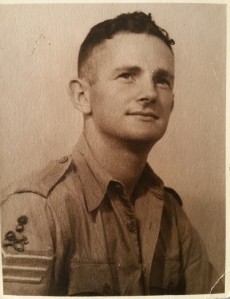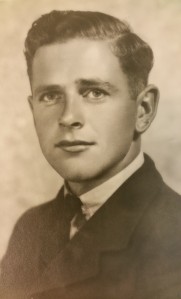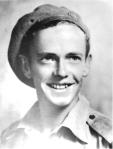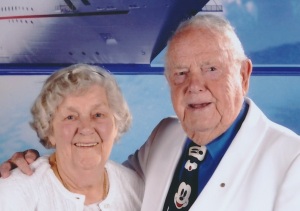My father had two brothers: his older brother, Robert, and his twin brother, Thomas. Both were killed in World War II.
Bob was a soldier in the 34th Fortress Engineers of the Australian Imperial Force (AIF). He was captured during the fall of Rabaul on 22 January 1942, held prisoner and half-starved at the Malaguna Road camp until he was put on the Japanese prisoner-of-war ship Montevideo Maru in late June. On 1 July 1942, the unmarked and unescorted Montevideo Maru was torpedoed off Luzon by the USS Sturgeon. The ship sank in six minutes. All 1,053 Australian prisoners of war were killed: it was Australia’s largest single loss of life in a single incident during the entire war. You can read Bob’s final letter by clicking on ‘Final Letters’ in the sidebar. I am named after this uncle.
Tom was a wireless air gunner on a Beaufort Bomber (popularly but irreverently known as ‘flying coffins’) in the RAAF’s 100 Squadron. He was shot down over Rabaul on his first mission on 14 December 1943. You can read Tom’s final letter by clicking on ‘Final Letters’ in the sidebar. My brother is named after this uncle.
My great uncle, Thomas Ince Farrell, was a soldier in the 16th Battalion of the AIF in World War I. He was killed in action at Pope’s Hill, Gallipoli ‘on or about’ 2 May 1915.
Another great uncle, Leslie Burrowes, was a trooper in the 10th Light Horse Regiment of the AIF in World War I. He was wounded in action three times at Gallipoli and died prematurely some years after the Great War.
In 1966, the year I turned 14, I decided that I would devote my life to answering two questions – Why are human beings violent? How can this violence be ended? – and taking action based on the learning that I would do by seeking answers to these two questions. This is more than a life passion: It is why I live.
Apart from four decades of involvement in nonviolent action campaigns, therefore, I have been engaged in an ongoing research effort since 1966 to find answers to these two questions.
The most important documents that have arisen from this research and nonviolent activism are as follows. Together they constitute an integrated and comprehensive strategy to end human violence and prevent human extinction:
The People’s Charter to Create a Nonviolent World The Nonviolence Charter was launched simultaneously around the world on 11 November 2011; it invites all people to join a worldwide movement to end violence in all of its forms.
Why Violence? This document offers a comprehensive explanation of why human beings are violent. It took me 41 years to learn the central insight that generated this document, now in its 9th edition. It is the primary outcome of 14 years of deep psychological investigation undertaken, while living in seclusion, by my soulmate and research colleague, Anita McKone, and myself from 1996 until 2010. Anita’s website, which includes her explanation of our process during this period – ‘Fearless Psychology and Fearful Psychology’ – and her songs of nonviolence, can be viewed here: AM.
Feelings First This website explains why emotional expression, despite having been violently discouraged in most human cultures, is at the core of our humanity and our life, if we are to live our life fully. It also explains how to restore emotional expression to the centre of your life (and recover from any psychological damage).
The Flame Tree Project to Save Life on Earth This document outlines a comprehensive strategy to end human violence (including environmental destruction) and prevent human extinction. It was written in conjunction with Anita.
The Strategy of Nonviolent Defense: A Gandhian Approach This book explains how to resist and defeat any form of military violence by using a strategy of nonviolent defence. I have presented the essence of this strategic thinking on the Nonviolent Defense/Liberation Strategy website. You can learn how to plan and implement a nonviolent defense or liberation strategy from this website.
Nonviolent Campaign Strategy This website describes how to plan and implement a nonviolent strategy to achieve a peace, environmental or social justice outcome.
The Political Objective and Strategic Goal of Nonviolent Actions This article explains the vital distinction, which is virtually never understood, between the political objective and the strategic goal of all nonviolent actions. It was originally published in Nonviolence Today 48, January-February 1996. pp. 6-7 but was republished in 2014. It will give you a taste of the strategic thinking mentioned above.
Nonviolent Action: Minimizing the Risk of Violent Repression This article explains 20 things that nonviolent activists can do to minimise the risk of military, police and provocateur violence at nonviolent actions. It was originally published under the title Minimising the Risk of Police Violence in Nonviolence Today 40, September-October 1994. pp. 17-18 but was revised for republication in 2014.
Nonviolent Intervention in Interpersonal Conflict This article explains how to safely and nonviolently intervene in violent conflicts between other individuals/groups. It was published in Nonviolence Today 44, May-June 1995. pp. 4-6.
You can see a more complete list of my publications by clicking on ‘Publications’ in the sidebar.
I spent five years working (full-time) as Honorary State Secretary of The Royal Life Saving Society – Australia, Victoria Branch from 1975-1981, during which I developed the philosophy and core content of what became known, in 1982, as the ‘Swim and Survive’ learner swimmer scheme. This scheme has substantially reduced the drowning toll in Australia.
One of the many instructive experiences of my life was the time I spent working in the Shagarab East 2 Refugee Camp in eastern Sudan in 1985. This camp held 20,000 Tigrayan refugees who had just fled the Ethiopian war and famine. I was part of a Community Aid Abroad (Oxfam in Australia) refugee health team. Despite our best efforts, 5 people died in our camp every day. On one occasion, I was urgently summoned to perform cardio-pulmonary resuscitation (at which I had been expertly trained during my years as a lifesaver) on an emaciated three month old baby while her distraught parents looked on. I could not save her.
Since 1981, I have been involved in many nonviolent action campaigns in relation to peace, environmental and social justice issues. These include refusing to vote (since 1981), the Franklin River Blockade (1982-1983), the campaign to end nuclear warship visits to Australian ports (1987-1988), the campaign to remove US military bases from Australian soil (1989), campaigns to halt the destruction of old-growth forests in south-eastern Australia (1989-1990) and the campaign to end duck shooting (1989-1990).
My involvement in these and other campaigns has led to my arrest on about 25 occasions and to brief terms of imprisonment on about 15, including one in which I was imprisoned in a psychiatric ward and forcibly injected with ‘anti-psychotic’ drugs. During each of these terms of imprisonment, I have fasted until it was time for my release or I was given the organically/biodynamically grown, vegetarian wholefood that I had requested. There have been many other outcomes from my involvement in these campaigns, including the learning I did which enabled me to write and publish strategic analyses of many of them: see relevant articles in the list of publications.
Apart from the campaigns just mentioned, however, the three campaigns in which I have been most heavily involved are as follows:
War Tax Resistance: I have been a conscientious war tax resister since 1983. Among many outcomes, this has led to the seizure of my bank account in 1984, my bankruptcy in 1991, my conviction for contempt of court (because of my conscientious refusal to cooperate with the bankruptcy trustee) in 1992, and the seizure of my passport in 1993. You can read my defence presentation to the Federal Court of Australia during my bankruptcy trial by clicking on ‘Court Defence’ in the sidebar.
Melbourne Rainforest Action Group: I was heavily involved in the nonviolent action campaign of the Melbourne Rainforest Action Group in 1988-1990. This campaign was extremely effective, substantially reducing Australia’s imports of rainforest timber from South East Asia, thus slowing rainforest destruction in that region. There is a video of this campaign, which includes graphic footage of nonviolent actions and a brief explanation of the group’s nonviolent strategy by me:
Gulf Peace Team: I was a member of the international Gulf Peace Team: the 73 people from 16 countries who camped on the border between Iraq and Saudi Arabia in an attempt to prevent the Gulf War in January 1991. I wrote a strategic analysis of this experience in ‘The Persian Gulf War and the Gulf Peace Team’ in Yeshua Moser-Puangsuwan and Thomas Weber (eds.) Nonviolent Intervention Across Borders: A Recurrent Vision (Honolulu: University of Hawai’i, 2000). I also wrote the typology of nonviolent intervention on which this book is based: ‘Cross-border Nonviolent Intervention: A Typology’. I did a television interview about the Gulf Peace Team on 1 February 1991, just hours after we arrived in Amman from Baghdad:
Apart from the websites mentioned above, I maintain the Global Nonviolence Network (GNN) website. The GNN lists nonviolence organisations by region and country around the world: GNN.
So who am I? I am my two uncles and hundreds of thousands of Iraqis killed in war. I am the refugees who died in the Shagarab East 2 Refugee Camp. And I am the wildlife and trees destroyed in the rainforests of South East Asia. Who else could I be?
The purpose of violence is to suppress awareness of the truth.
…..
Acknowledgements
I would like to express my deep gratitude to my parents, Beryl & James, veterans of World War II, who have never failed to find the love that I have needed to undertake my life’s work.
They are truly the greatest parents of all.
Many others have helped at times and I deeply appreciate their support. If you would like to help Anita’s and my work to end human violence, please consider financially supporting us by clicking on ‘Financial Support’ in the sidebar.
Robert J. Burrowes
P.O. Box 68
Daylesford
Victoria 3460
Australia
Email: flametree@riseup.net





